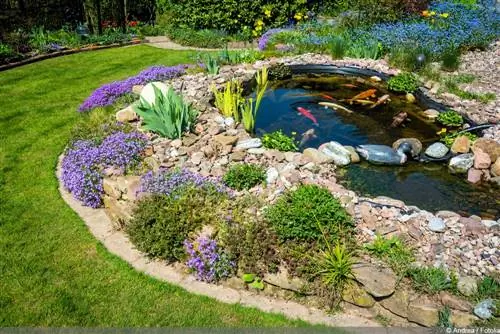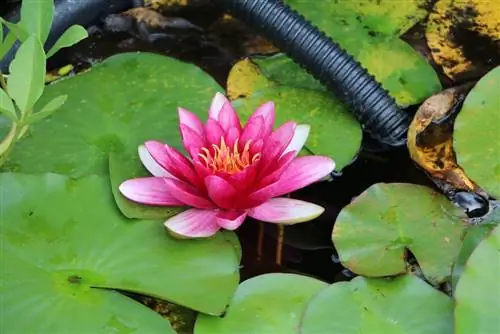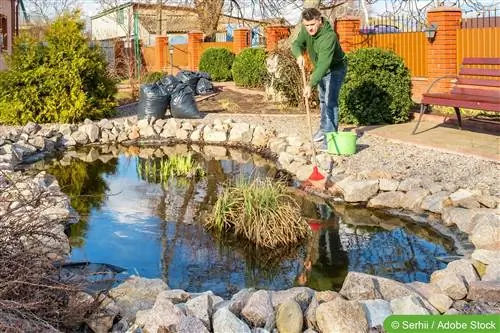- Author admin [email protected].
- Public 2023-12-17 03:39.
- Last modified 2025-01-24 12:45.
A garden pond can quickly become a nightmare - namely if a child falls into the pond, gets injured or even drowns. Security measures are therefore essential. These can, under certain circumstances, disturb the appearance, but in case of doubt they can also save you a lot of trouble. And they protect lives. Fortunately, child protection for garden ponds can usually be installed quickly and inexpensively.
Problem
Water magically attracts children. They love playing with it and splashing around in it. Of course, this applies to your own children as well as those in the neighborhood. A garden pond therefore also represents a risk if you don't have any children yourself. In principle, no one is obliged to secure their pond so that no one can fall into it. However, it is a question of responsibility to do it anyway. Quite apart from the fact that a drowned or injured child in the garden causes a lot of trouble and suffering, even without any criminal implications. But why can a small, not particularly deep garden pond become a fatal trap for children? The answer: Because smaller children in particular can fall in very easily, lose consciousness and then drown despite the shallow depth.
Safety measures
A pond can be made childproof in many ways. The aim is to either make access more difficult or impossible or to minimize the risk of stumbling. Here we want to take a closer look at five different options. Which measures you ultimately decide on depends on the specific conditions on site and your own requirements. It should always be clear to you that securing a pond usually also has a visual impact. It is therefore important to keep this impairment as low as possible:
Flat shore
It's easiest if you take the security of your garden pond into account when planning. Basically, a pond in the garden can be created in two ways. Either you dig a hole and line it with a pond liner or you place a prefabricated plastic tub in it. The pond liner variant is the more common and usually more sensible solution. Above all, it also offers the opportunity to install a relatively simple but effective protective measure right from the start. As already mentioned, the biggest danger for children is that they stumble on the edge of the pond and then fall into the water. This risk can now be significantly minimized by ensuring that the bank is very flat. A steep bank must be avoided at all costs. The bank should meet the following requirements:
- sloping very slowly towards the middle of the pond
- no abrupt depressions
- free from tripping hazards such as stones or decorative objects
- Placement of smaller, rough natural stones on the edge
A flat bank not only reduces the risk of stumbling, but in case of doubt it also makes it easier for the child to get out of the pond on their own. This is supported by rough stones on the edge of the bank, which the child can use to pull themselves out. However, you should be aware that a flat bank always requires more space than a steep bank. The pond must therefore be larger overall. How slowly the bank can slope towards the middle of the pond ultimately depends on the total area of the pond. Nevertheless, a flat bank is the safety measure that causes the least visual impairment.
Tip:
Never use smooth stones or wood to border the bank at the edge of the pond. When these elements are wet, they become very slippery, making it much more difficult to hold on.
Fence
The classic way to secure ponds of all kinds is certainly a fence. It can reliably ensure that children are prevented from accessing the pond. However, for this to really work, it should be at least around one meter high. It should also be created around the entire pond. It makes sense to have a small door that can be locked and that should also be locked. Plug-in fences made of metal, wood or plastic are recommended for fence construction. Stability is important. A simple chain link fence is not suitable. It can also make sense to let the fence slope down towards the pond at an angle of 45 degrees. As a rule, this creates a distance that makes it virtually impossible for small children to overcome.
Planting

A fence around the garden pond is certainly not a tempting idea for many people, as it contradicts exactly the idyll that was wanted to create with the small body of water. An alternative could be to plant hedges and bushes as densely as possible. Boxwoods and roses are also perfect for this. It's simply a matter of creating a barrier around the pond that children find difficult or impossible to overcome. Planting also has the great advantage that the pond behind it remains largely hidden. However, it is important that it is created early. In order to achieve dense growth and a certain height, plants simply need a certain amount of time.
Net or grid
To prevent children from falling into the pond, a tear-resistant net can also be attached over it or at the level of the water. The closer it is to the water, the less noticeable it is. The tent is attached to the edge of the bank, for example using tent pegs that are driven into the ground. A pond cover with a metal grid works similarly to a net. However, it is much more noticeable, more complex and therefore usually significantly more expensive. Most of the time it has to be made individually. However, a wrought iron grille can also have a very special appeal and become an eye-catcher in the garden.
Alarm detector
So-called alarm devices that float like small islands on the water surface of the pond are now available from specialist retailers. As soon as they detect a large wave movement, such as that caused by a child falling, they emit a loud, shrill alarm sound. Various tolerances can be set, for example to prevent every frog that jumps into the water from immediately triggering an alarm. It is also important that these alarms lie very flat on the surface in order to function optimally. And of course such a warning alarm only makes sense if adults react to it and, in case of doubt, can pull the child out of the pond.






